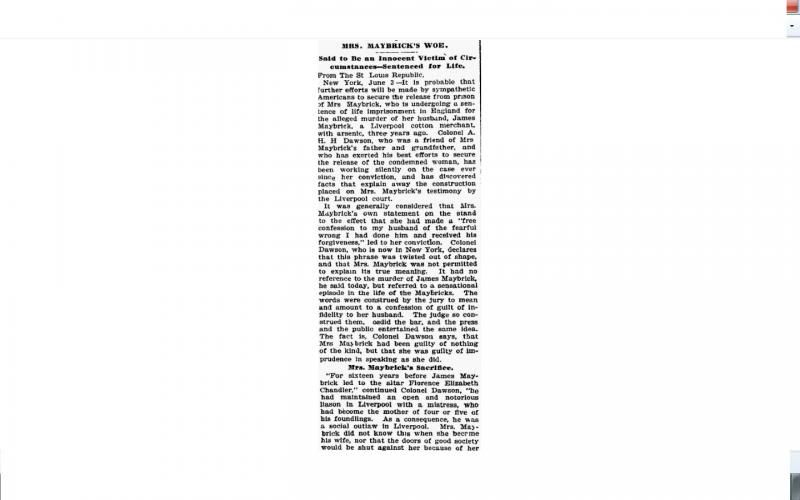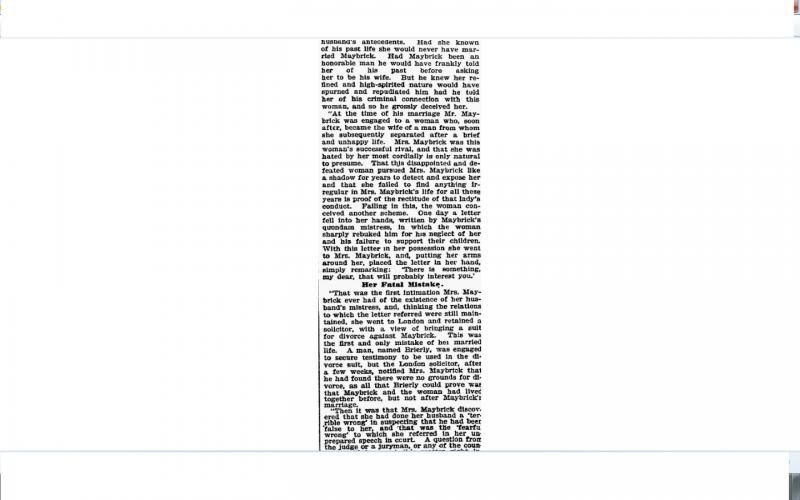I have re-read the Diary to refresh my memory regarding the writer’s claims.
For starters the coincidence of his working in Lime Street in the City is not mentioned.
Maybrick was supposed to be a joker who liked to play on such coincidences. Lime Street is and was in 1888 the main railway station in Liverpool.
The Diary claims that Whitechapel was selected because it was in London, and because of the coincidence of name with the Liverpool district were Maybrick says he first saw his wife with her lover (even though they claimed to have only started their affair in November 1888 – i.e. after the murder the Diary claims Maybrick committed).
‘I know for certain she has arranged a rondaveau with him in Whitechapel… it was there I finally decided London it shall be. And why not, is it not an ideal location? Indeed do I not frequently visit the Capital and indeed do I not have legitimate reason for doing so.’
The writer claims Maybrick was a frequent visitor to London anyway!
The writer also claims that Maybrick deliberately made the Whitechapel area his comfort zone – by learning the street layout…
‘I have taken a small room in Middlesex Street, that in itself is a joke… It is indeed an ideal location. I have walked the streets and have become more than familiar with them. I said Whitechapel it will be and Whitechapel it shall. The bitch and her whoring master will rue the day I first saw them together. I said I am very clever, very clever. Whitechapel Liverpool, Whitechapel London, ha ha. No one could possibly place it together. And indeed for there is no reason for anyone to do so.’
In 1891 Alexander MacDougall published some details concerning the relationship between Sarah Robertson and Maybrick, but only referred to her as Mrs Maybrick and did not mention any East End connection.
MacDougall’s treatise was very sympathetic to Florence Maybrick and claimed she was innocent of James Maybrick’s death, for which she had just been found guilty.
It was clearly written with the assistance of Florence Maybrick’s defence team, headed by Sir Charles Russell.
It was from a transcribed document from the Russell papers that pretty much all the information about Sarah Robertson, by name, derives.
It seems obvious that Sarah Robertson presented this information to the defence team herself.
I don’t believe that the information pertaining specifically to Sarah Robertson by name was published until after the Diary was released. (Or was she mentioned by name in the 1968 book Etched in Arsenic?)
While I am not sure whether Maybrick lived in or even visited Sarah Robertson’s Bromley Street address, there would have been reason viz-a-viz the Whitechapels to ‘place it together’. In other words there were people who would have known Maybrick who lived in the East End.
No aspect of Maybrick’s relationship with Robertson gets mentioned in the diary.
This is because her name was not known until after the Diary’s publication.
Similarly the writer of the Diary had Maybrick premeditatedly and artificially acquire a comfort zone in the London Whitechapel (a location selected purely because it the name matched the Liverpool district) by walking the streets to gain familiarity.
One other thing about Sarah Robertson.
If she had five or six children by Maybrick (and this wasn’t a figment of her imagination) then they were not born with the name Maybrick, even though she sometimes chose to call herself by that name and seems to have told her relatives that she was married to James Maybrick.
So why didn’t she register all these children with the name Maybrick?
Clearly she knew the nature of her relationship with James Maybrick and repeatedly (so it’s claimed) bore him children despite this.
What does this say?
Maybrick mentions his children by Florence several times in the diary. He never mentions any children by Sarah Robertson.
For starters the coincidence of his working in Lime Street in the City is not mentioned.
Maybrick was supposed to be a joker who liked to play on such coincidences. Lime Street is and was in 1888 the main railway station in Liverpool.
The Diary claims that Whitechapel was selected because it was in London, and because of the coincidence of name with the Liverpool district were Maybrick says he first saw his wife with her lover (even though they claimed to have only started their affair in November 1888 – i.e. after the murder the Diary claims Maybrick committed).
‘I know for certain she has arranged a rondaveau with him in Whitechapel… it was there I finally decided London it shall be. And why not, is it not an ideal location? Indeed do I not frequently visit the Capital and indeed do I not have legitimate reason for doing so.’
The writer claims Maybrick was a frequent visitor to London anyway!
The writer also claims that Maybrick deliberately made the Whitechapel area his comfort zone – by learning the street layout…
‘I have taken a small room in Middlesex Street, that in itself is a joke… It is indeed an ideal location. I have walked the streets and have become more than familiar with them. I said Whitechapel it will be and Whitechapel it shall. The bitch and her whoring master will rue the day I first saw them together. I said I am very clever, very clever. Whitechapel Liverpool, Whitechapel London, ha ha. No one could possibly place it together. And indeed for there is no reason for anyone to do so.’
In 1891 Alexander MacDougall published some details concerning the relationship between Sarah Robertson and Maybrick, but only referred to her as Mrs Maybrick and did not mention any East End connection.
MacDougall’s treatise was very sympathetic to Florence Maybrick and claimed she was innocent of James Maybrick’s death, for which she had just been found guilty.
It was clearly written with the assistance of Florence Maybrick’s defence team, headed by Sir Charles Russell.
It was from a transcribed document from the Russell papers that pretty much all the information about Sarah Robertson, by name, derives.
It seems obvious that Sarah Robertson presented this information to the defence team herself.
I don’t believe that the information pertaining specifically to Sarah Robertson by name was published until after the Diary was released. (Or was she mentioned by name in the 1968 book Etched in Arsenic?)
While I am not sure whether Maybrick lived in or even visited Sarah Robertson’s Bromley Street address, there would have been reason viz-a-viz the Whitechapels to ‘place it together’. In other words there were people who would have known Maybrick who lived in the East End.
No aspect of Maybrick’s relationship with Robertson gets mentioned in the diary.
This is because her name was not known until after the Diary’s publication.
Similarly the writer of the Diary had Maybrick premeditatedly and artificially acquire a comfort zone in the London Whitechapel (a location selected purely because it the name matched the Liverpool district) by walking the streets to gain familiarity.
One other thing about Sarah Robertson.
If she had five or six children by Maybrick (and this wasn’t a figment of her imagination) then they were not born with the name Maybrick, even though she sometimes chose to call herself by that name and seems to have told her relatives that she was married to James Maybrick.
So why didn’t she register all these children with the name Maybrick?
Clearly she knew the nature of her relationship with James Maybrick and repeatedly (so it’s claimed) bore him children despite this.
What does this say?
Maybrick mentions his children by Florence several times in the diary. He never mentions any children by Sarah Robertson.




Comment